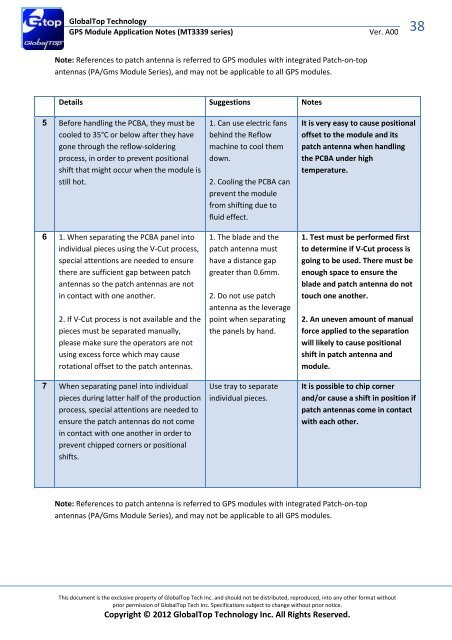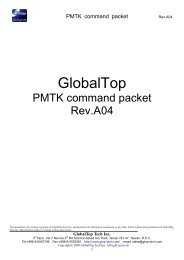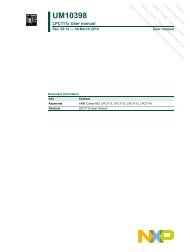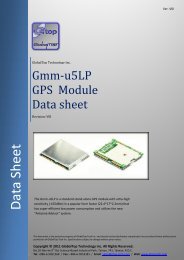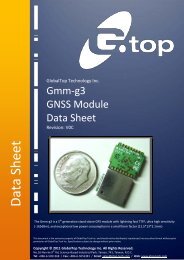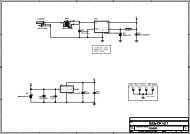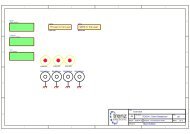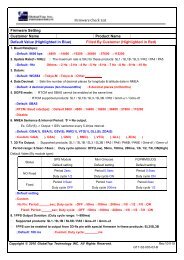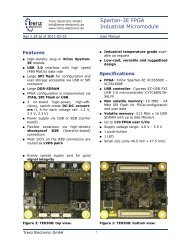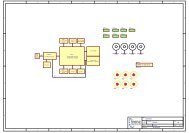Gtop Module Application Note -A00 _MT3339 series_.pdf
Gtop Module Application Note -A00 _MT3339 series_.pdf
Gtop Module Application Note -A00 _MT3339 series_.pdf
You also want an ePaper? Increase the reach of your titles
YUMPU automatically turns print PDFs into web optimized ePapers that Google loves.
GlobalTop Technology<br />
GPS <strong>Module</strong> <strong>Application</strong> <strong>Note</strong>s (<strong>MT3339</strong> <strong>series</strong>)<br />
<strong>Note</strong>: References to patch antenna is referred to GPS modules with integrated Patch-on-top<br />
antennas (PA/Gms <strong>Module</strong> Series), and may not be applicable to all GPS modules.<br />
Details Suggestions <strong>Note</strong>s<br />
5 Before handling the PCBA, they must be<br />
cooled to 35°C or below after they have<br />
gone through the reflow-soldering<br />
process, in order to prevent positional<br />
shift that might occur when the module is<br />
still hot.<br />
6 1. When separating the PCBA panel into<br />
individual pieces using the V-Cut process,<br />
special attentions are needed to ensure<br />
there are sufficient gap between patch<br />
antennas so the patch antennas are not<br />
in contact with one another.<br />
2. If V-Cut process is not available and the<br />
pieces must be separated manually,<br />
please make sure the operators are not<br />
using excess force which may cause<br />
rotational offset to the patch antennas.<br />
7 When separating panel into individual<br />
pieces during latter half of the production<br />
process, special attentions are needed to<br />
ensure the patch antennas do not come<br />
in contact with one another in order to<br />
prevent chipped corners or positional<br />
shifts.<br />
1. Can use electric fans<br />
behind the Reflow<br />
machine to cool them<br />
down.<br />
2. Cooling the PCBA can<br />
prevent the module<br />
from shifting due to<br />
fluid effect.<br />
1. The blade and the<br />
patch antenna must<br />
have a distance gap<br />
greater than 0.6mm.<br />
2. Do not use patch<br />
antenna as the leverage<br />
point when separating<br />
the panels by hand.<br />
Use tray to separate<br />
individual pieces.<br />
Ver. <strong>A00</strong><br />
It is very easy to cause positional<br />
offset to the module and its<br />
patch antenna when handling<br />
the PCBA under high<br />
temperature.<br />
1. Test must be performed first<br />
to determine if V-Cut process is<br />
going to be used. There must be<br />
enough space to ensure the<br />
blade and patch antenna do not<br />
touch one another.<br />
2. An uneven amount of manual<br />
force applied to the separation<br />
will likely to cause positional<br />
shift in patch antenna and<br />
module.<br />
This document is the exclusive property of GlobalTop Tech Inc. and should not be distributed, reproduced, into any other format without<br />
prior permission of GlobalTop Tech Inc. Specifications subject to change without prior notice.<br />
Copyright © 2012 GlobalTop Technology Inc. All Rights Reserved.<br />
38<br />
It is possible to chip corner<br />
and/or cause a shift in position if<br />
patch antennas come in contact<br />
with each other.<br />
<strong>Note</strong>: References to patch antenna is referred to GPS modules with integrated Patch-on-top<br />
antennas (PA/Gms <strong>Module</strong> Series), and may not be applicable to all GPS modules.


